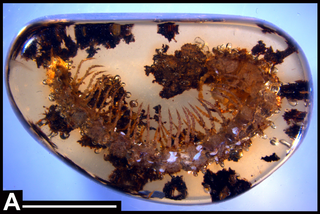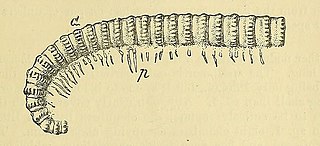 W
WAmynilyspes is an extinct genus of pill millipedes characterized by fourteen tergites, large eyes, and prominent spines. Individuals measure up to 30 mm (1.2 in) in length.
 W
WAnbarrhacus is an extinct genus of millipede in the family Platyrhacidae known from a fossil found in North America. There is one described species in the genus, Anbarrhacus adamantis, which is one of three millipedes described from Mexican amber.
 W
WArchidesmus is an extinct millipede genus from the Lower Devonian Old Red Sandstone of the United Kingdom. It is the only member of the taxonomic family Archidesmidae. Individuals were up to 5 cm (2.0 in) long, and had 60 to 80 body segments decorated with tubercles (bumps) on the upper surface, and most segments possessed wing-like keels (paranota) extending to the side. The type species Archidesmus macnicoli was described by British paleontologist Benjamin Peach in 1882. A second species, A. loganensis was also described by Peach but its status as a valid species- or even a myriapod- is debated.
 W
WLatzelia is an extinct genus of scutigeromorph centipedes, and the type and only genus of the family Latzeliidae. It existed during the Carboniferous in what is now Illinois. It was described by Samuel Hubbard Scudder in 1890, and the type species, and only known species, is Latzelia primordialis. The genus name honors Austrian zoologist Robert Latzel.
 W
WMaatidesmus is an extinct genus of millipede in the family Chelodesmidae known from a fossil found in North America. There is one described species in the genus, Maatidesmus paachtun, one of three millipedes described from Mexican amber.
 W
WMyriacantherpestes is an extinct genus of spiny millipedes from the Pennsylvanian subperiod of the Carboniferous period, known from fossils in Europe and North America.
 W
WPalaeosoma is an extinct genus of archipolypodan millipedes from the upper Carboniferous of England and Poland. Individuals grew to nearly 20 cm (7.9 in) long and possessed defensive glands (ozopores) located on small raised nodes on the outer edges of the upper surface of each body segment. Species of Palaeosoma were once considered members of the family Euphoberiidae, which contains species with prominent spines, but are now classified in their own family (Paleosomatidae) and own order (Palaeosomatida), as they lack spines and have a combination of features not seen in other Paleozoic millipedes.
 W
WPneumodesmus newmani is a species of myriapod that lived in the Paleozoic. Its exact age is uncertain; it was originally interpreted as living 428 million years ago, in the Late Silurian; however, the study conducted by Suarez et al. (2017) indicates that it actually lived in the Early Devonian (Lochkovian). It is one of the first myriapods, and among the oldest creatures to have lived on land It was discovered in 2004, and is known from a single specimen from Stonehaven, Aberdeenshire, Scotland.
 W
WXyloiulus is an extinct genus of millipede that lived during the Late Carboniferous which grew up to 2.25 inches (5.7 cm) in length. Fossils of the animal have been found in North America and Europe. The fossils are typically found in Sigillarian stumps.